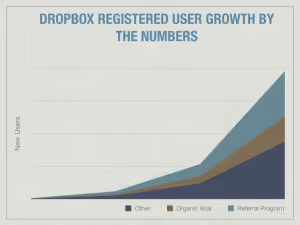3900% Growth – Dropbox Customer Referral Program by the Numbers
The Dropbox customer referral program is probably one of the most famous examples of a customer referral program on the internet today.
It's often used to showcase just how powerful of a growth engine refer-a-friend programs can be, and also how important optimization work by people like Sean Ellis is.
All of the above is true; especially with their dazzling growth numbers of 100k registered users to 4M registered users in just 15 months. That’s a 3900% growth over 15 months!
While these numbers are impressive, they don't tell the whole story. Before you can imitate their success it's important to break these numbers down to understand exactly what 3900% growth looks like per month with respect to the customer referral program.
The Dropbox Presentation
If you haven't seen the presentation by Dropbox on their explosive growth I would highly recommend you view it by clicking here. Slides 28 - 32 talk specifically about the referral program but the whole presentation is a interesting read.
The Numbers Extracted
The numbers shared in the presentation with respect to the customer referral program are:
- 100,000 registered users in 2008
- 4M registered users within 15 months
- 35% of daily signups from referral program
The Missing Variables
The magnitude of the numbers above is impressive. If those numbers were 10 users to 400 users in 15 months we probably wouldn't be talking about this referral program right now. However, this is not to say that the referral program wouldn't have been successful. To compare referral programs we need to look at monthly growth rate, not absolute numbers.
So, unless you have 100k users you are actually going to need to know the rate of growth Dropbox experienced from their customer referral program to determine if your program is doing well in comparison.
Specifically, the variables we are looking to compute are:
- Rate of registered user growth
- Rate of registered user growth as a result of the referral program
Our Assumptions
To estimate what these rates were during the 15 months covered in the presentation, we will have to make several assumptions.
First, we will assume that Dropbox grew exponentially and not linearly. This makes sense if you think that as the active user base got larger, there would be more people making referrals, and thus more signups occurring due to referrals.
Second, we also assumed that the conversion rate of the referral program remained constant. The Dropbox presentation mentioned that they optimized the program over time so we know this isn't true. However, the variations will be negligible as long as you are looking to compare the performance of a referral program with some history instead of one in its first months of use.
Exponential Growth
To discover the rate of growth of registered users we're going to need to use some algebra, a single formula, and the starting numbers provided in the presentation.
Don't worry if it's been a while since you used this type of math. We will go through everything step-by-step.
As we stated before, we are assuming that Dropbox grew exponentially. This means that to discover their monthly growth rate, we need to start with the exponential growth formula.
y = a(1+b)^x
To learn more about the exponential growth click here.
A is the number of registered users Dropbox started with.
A = 100,000
X is the number of months that growth was observed for.
X = 15
B is the rate of monthly growth.
B = ?
Y is the number of registered users at the end of the 15 months.
Y = 4,000,000
Solve for Rate of Registered User Growth
4,000,000 = 100,000 (1+b)^15
sqrt ( 4,000,000 / 100,000)^(1/15) = 1 + b
1.279 - 1 = b
b = 27.9%
This means that during the 15 months in question Dropbox was growing at approximately 28% per month.
Rate of Registered User Growth as a Result of the Referral Program
It's important to remember that the referral program was not responsible for all of this growth.
Organic viral loops (i.e. the sharing of files), media coverage, general word of mouth, and more were all responsible for a portion of their growth too.
Luckily, the presentation tells us that they attributed 35% of daily signups to the customer referral program.
35% * 27.9% = 9.76% monthly growth
This leads us to calculate that the customer referral program was delivering 9.76% monthly growth of registered users.
Testing our Calculations
When we reverse engineer calculations from a presentation like this it is important to verify that our calculations make sense. This is to say, are reasonable compared to the other information we are presented.
The presentation states that DropBox maintained 15-20% month-over-month growth since launching their referral program.
Remembering that they also said 35% of daily signups we from the referral program we can calculate an estimated growth rate as a result of the referral program.
15% growth * 35% referral program = 5.25% monthly growth
20% growth * 35% referral program = 7% monthly growth
These results are within the same approximate range as our calculated number of 9.76% and thus we feel our calculations are reasonable.
Conclusion
During the 15 months discussed in this presentation:
- Dropbox grew their registered user base at 27.9% a month,
- The Dropbox referral program grew their registered user base by between 5.25% - 9.76%,
- The referral program was an effective part of the Dropbox growth strategy.
What this means for you
Customer referral programs are powerful growth engines especially for products that have strong customer bases and have found product market fit.
With optimizations, testing, and time a referral programs could provide considerable growth to your registered user base.
Your customer referral program is not a silver bullet. It is a powerful component of a complete growth strategy.
